The above is “The Old House-Green Mont” by Betsy Rust, 1939. It shows the smoke house, the wood shed , and the old log cabin, with attached privy
The Land
The earliest located record of the land which includes Green Mont is the transfer from Henry Peyton Sr. to his son, Henry Peyton Jr. on March 18, 1794 (FCDB 4 pg. 501);
…bounded as followeth, Beginning at Foley’s Cool Spring Branch where it empties into Broad Run, then running up the branch to Foley’s Line, thence with said line to a white oak corner to said Foley standing on the East side of the Branch, thence with the said Foley’s Line to the dividing corner between said Foley and William Smith, thence with said Smith’s line to his spring branch, thence down the spring branch to Broad run, thence down the said run the several courses and meanders thereof to the Beginning, together with all houses, out houses, gardens, orchards, meadows, ways, waters and water courses, profits, commodities and advantages to the said land and premises belonging or in anywise appurtaining, and the reversion and reversions, remainder and remainders, rents, issues and profits thereof, and also the estate right, title, interest, property claim and demand whatsoever of the said Henry Peyton of, and into the said land and premises, and all deeds, evidences and writings touching or in any wise concerning the same.
Earlier records, such as the will of John Peyton, the elder Henry Peyton‘s father, which was recorded at the Stafford County Courthouse, were burned during the Civil War. John Peyton, 1691-1760, is considered the original owner of the land. He received a land grant in the Pignut Mountain area and other properties between 1741 and 1745. His son, Henry Peyton, was the first Peyton to live on the land.
In 1822, part of the Peyton property, consisting of 250 acres, two roods and 36 poles was put under a trusteeship to settle various debts. The trustee was Walter A. Smith of the neighboring farm known as “Mount Eccentric”. In 1839, 202 of the 250 acres, were deeded to William Temple Smith, son of Walter A. Smith. A survey from March 15, 1831 indicates the 202 acres and the presence of at least two structures, the larger of which seems to have been the core of the “Green Mont” main house.
Mary Lee Fleming purchased the property on July 12, 1877 from William Temple Smith et. al. in a bankruptcy sale for $7,500. The property consisted of 202 acres and was referred to as “Home Tract” in those documents. (FCDB 69 pg. 117-119). Mary Lee Fleming purchased an additional parcel for $156 containing 5 acres along the NE boundary (following the road) from Robert and Alice Murray (FCDB 87 pg. 296). Upon her death in 1901, both parcels were left to R. B. Lee Fleming. Ownership of the properties was transferred to R. B. Lee Fleming by the remaining heirs on May 16, 1903 for the sum of $1 (FCDB 94 pg. 294).
I examined an early survey description of Green Mont looking for clues. Although the farm was later surveyed in 1981, at the point of my father’s gifting of the farm to his children on December 29, 1976, the only official description of the property was still based on the May 30, 1903 survey that was used when Richard Bland Lee Fleming inherited Green Mont from his mother’s estate. This survey, rather loose by today’s standards, describes the farm’s boundaries by stone piles at the side of the road, oak trees and old stumps; measured in “poles” and “links” (there are 5 1/2 yards in a pole).
I then discovered that the 1903 survey was actually the March 15, 1831 survey prepared at the request of Capt. Henry Peyton. The original surveyed acreage of Home Tract in was noted as 202 plus the 5 acres later purchased from “Murray”. When my father had the property subdivided, the new survey, dated Jan 27, 1981, his 67th birthday, showed the acreage as 212. With boundaries involving 150 year old tree stumps… go figure.

Around 1900, the Mary Fleming purchased an additional tract known as The Carver Farm. There was a Carver’s Mill sited on that farm, however by 1900, that mill was nothing more than a ruin. Many farms located along a healthy stream like Broad Run had mills at one time or another.
As Lee (Jr.) was building up the dairy in the 1930’s, he found he needed more pasture and added yet another farm to the family holdings. This farm is known as “Difficulty”, probably due to the numerous rock outcroppings.
The 1984 Archeological Survey
This historical records search was performed in 1984 by Bill and Randi Rust with their then organization called Coastal and Piedmont Studies, Assoc.; part of their Loudoun Archeology Center in Leesburg. I also commissioned them to perform an archeological survey of the Green Mont house site . There was a formal report provided.
I was interested in whatever the survey would turn up, but one of my main interests was to determine if any earlier structures had existed at the site. None were discovered.
Also of interest was the age of the log cabin, to determine if it preceded the main house, and if it had ever been used as a habitation, or, perhaps, a slave quarters. The consensus was that the age of the cabin was between 1840 and 1850, based on the quality of the craftsmanship and construction trends of the day. There was no evidence of significant domestic activity in the cabin. Artifacts, including inkwells and broken slates suggest that the building might have been used as a school house. A local school was known to have been in the area. I later found a copy of a news paper advertisement soliciting students for a school that was being started on the property of Wm. Temple Smith. I believe the cabin housed that school, known as the Pignut Seminary; called that, I assume, as it was in the shadow of Pignut Mountain.
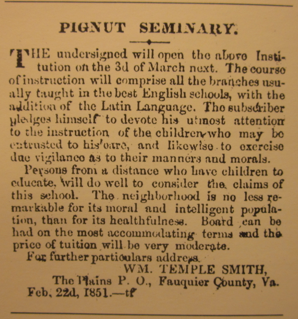
Lee Rust: I’m charmed by the idea that the old log cabin was likely the schoolhouse where several generations of neighborhood students got their readin’, writin’ and Latin lessons. I once considered ‘Pignut’ for a record label, but ‘Pignut Academy’ would make a great name for the string band you’ll be starting someday.
The House
The 1822 survey is illustrated with two structures. One of these structures is located at the current house site and conforms to the basic the nature of the Green Mont house. The house, drawn much as it appears as in the 1891 picture at the heading of this page; 2 story, 3 bay, central door, and a chimney at each end, was clearly present on the site in 1822. This date is consistent with the construction materials and techniques of the oldest rooms of Green Mont. We never were able to identify the second building represented. It was not any building I was familiar with. The house itself is the only building on site old enough to have been indicated by that 1822 illustration.
The first floor flooring was removed in 1984 to examine the rotted and heavily termite damaged mud sills and joists. The construction of the earliest rooms was revealed to be an early stud framing style, still retaining some aspects of heavy timber framing techniques; mortise and tenon joints and hewn timbers, consistent with the period of 1800 to 1820. We were also able to determine that the East (Parlor) section had been built first. It was, soon thereafter, expanded to include the center hall and the Western (Dining) room along with its basement. This seems to conservatively date the earliest portions of the house to 1820, or even slightly before.
It is likely that in about 1840, a 2 story extension was built to the North (rear) of the center hall creating a “T” configuration, with a 2 story porch along the west side of the “T”. At this time, the original second floor (which probably had a lower ceiling height) was taken off and replaced at a height matching the new addition. The stairs may also have been moved into the addition at this time. An additional root cellar, connecting to the existing basement room, was located under the new west porch. The single bay front porch visible in the 1891 photo may have been added at this time.
Several smaller additions were made in the vicinity of the 1840’s West porch. The porch was ultimately fully enclosed and extended to accommodate pantries and a store room on the 1st floor and two additional small bedrooms on the 2nd floor increasing the number of bedrooms on the second floor to six.

To the West, and slightly to the North (rear) was built a two story outbuilding. This served as a kitchen and laundry on the first floor, and had 3 servants bedrooms on the upper level. A covered connection to the main dwelling was made at some point with an “L” shaped porch, connecting to a side door on the west. The nature of the construction indicates that this was likely built between 1860 and 1880. It could have been built just before the Civil war, or just after. It might even have been built by the Flemings. The Kitchen building is clearly visible in the 1891 photograph.
There was no evidence of a “cooking ” fireplace in the main dwelling so there was almost certainly an outbuilding for cooking, even from the houses earlier stages. No evidence of such a building was ever discovered. It is completely possible that all traces of such an earlier structure might have been erased by the construction of the 1840 addition or the newer “kitchen”, which had a full basement constructed with brick.
In 1901, a major reconstruction of the house was undertaken. The magnitude of the remodel suggests that the family might have even moved out while the work was undertaken. Either that or the construction was undertaken in such a way that only part of the house was out of commission at any one time. That would have been quite a challenge, and would have greatly expanded the construction time, and the cost.
The house was essentially reduced to its studs. It is hard to tell how much of the interior plaster was removed, but I would tend to say most of it was. All of the original single layer siding was removed and then reinstalled as diagonal sheathing. New “German” siding was installed over that. All the windows and exterior doors were replaced. A bay window was added to expand the Dining Room and the Bedroom above. The stairs were again removed and completely redesigned. The east wall of the Parlor was removed and pushed out 4 feet to align with the new Living room that was added on the North East. wide pocket doors were installed between the original Parlor and this new room. An entire Mansard roofed 3rd floor with 6 or 7 additional bedrooms was put on top and the basement was dug out and underpinned to accommodate the new steam central heating system. Additional framing was added to the floors in the oldest sections of the house to reinforce the already sagging floors. Finally, a new porch was added that wrapped the south and east sides of the house. Hard to imagine living through all that with 5 daughters, a 1 year old baby boy and another baby on the way.

I do not know who developed the design for this major expansion. W. H. Irwin Fleming, the future “family architect”, was only 19 or 20 at the time and not likely involved.
After this expansion was complete, Uncle Rob moved up to the third floor with the younger children. He would have been 46 then; and Clarissa, his pal (and sole heir), would have been 8 or 9. “Hattie”, then 45, was about to deliver Anne.
I’m not sure when the two bathrooms were installed, but it was some time later, perhaps @1910, because the plumbing was added externally. Wiring came along even later than that. Rural electrification was a slow process. That said, the Flemings seemed to have usually been one of the first on the block to have the latest conveniences.
(I have subsequently discovered that the last year that ice was harvested from the “ice ponds” was 1926. This is a good indication that electricity, and a refrigerator, had finally made their way to Green Mont.)
These interior pictures were taken in 1935.


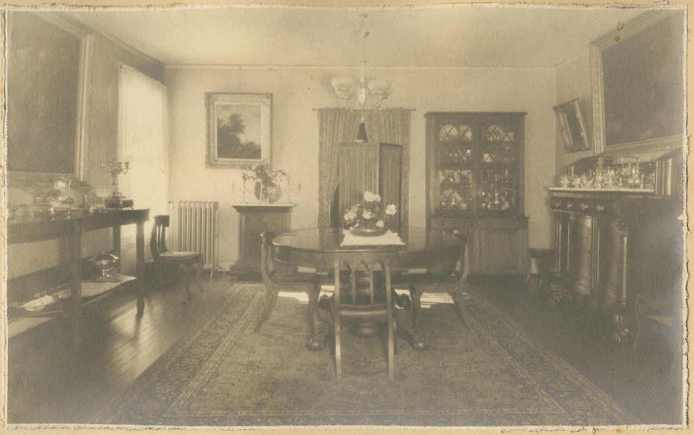
Lee made a few changes after he got control of the house in 1945. The old serving pantry was fitted out with a refrigerator and a small cook stove so that it could function as a stand alone kitchen. The roof was in poor repair by then. In 1948, Lee had Irwin Fleming design a new hipped roof to replace the leaking mansard. The 3rd floor bedrooms which, no longer needed, were removed in the process. The resulting appearance was quite a success, in my opinion. I believe that must have been when the dark green trim was changed to white. He also had Irwin sketch up some plans to convert the old Kitchen into a house for a farm manager but those plans were never acted upon.
The Conveniences
Green Mont, as well as everyone else of the time, had to be fairly self sufficient back in the day. I think they purchased salt and sugar and things of that sort, but just about all other food stuffs were grown or raised on the farm, or perhaps bartered with neighbors.
Furniture, clothing, pots and pans, tools etc. were all purchased or made by a local tradesman. Purchased goods were more precious than today, and lasted a long time and were often handed down from family member to family member. There was very little waste, and no such thing as packaging, other than barrels and sacks.
There were few public services and, of course, no public utilities. Water was obtained from either streams (for watering livestock and making ice) or from relatively shallow, hand dug wells. Water from the stream was raised by means of a simple pump called a “hydraulic ram” or “water ram”. It used the flow of the stream to force a piston to move a small amount of water up and out of the stream. This filled troughs for the animals and filled the ice ponds. A windmill was later used to lift well water for the livestock.
I don’t know where the first household wells were located which were probably accessed water by buckets or hand pumps. I do know that one well was located at the driveway end of the front entry walk,
Early in the Fleming’s tenure (perhaps in the 1890’s), a relatively sophisticated domestic water system was installed. Water was pumped from a spring in the front field about 80 feet up to a brick cistern, buried in the top of the hill behind the barnyard. An early “water jacket” single cylinder kerosene fueled engine would be operated, perhaps weekly, to pump water up to this cistern. The cistern, functioning essentially as a water tower, would feed the water (under pressure because of the higher elevation of the cistern) back to the house site. This gave them water on tap, very much like today.
This cistern system was still in operation when we first moved to the farm, although it was then fed by a deep drilled well with a contemporary submersible electric pump. It was the best tasting water. About once a week, you’d walk out to the well and flip a switch. About an hour later you went out and turned off the pump. The next time the water pressure got low in the upstairs bathroom, you’d go back out and flip the switch again. When you forgot to turn the pump off afterwards, you heard someone yelling very loudly. An automatic system pressure tank system was installed by my father when the old original pipes to the cistern started to fail. The water never tasted the same again.
There are two shallow ponds graded into the stream bottom field below the bank barn. In the days before electric refrigeration, these ponds would be filled in the winter to a depth of a foot or so and allowed to freeze solid. This ice was then sawn into manageable blocks and carted up to the “Ice House”, which was located at the rear of the vegetable garden.
The Ice House consists of a cylindrical stone walled pit about 14 feet in diameter and extending approximately 20 feet into the ground. There was a roof constructed over the pit with a hoisting beam for a rope and pulley system (attached to large Ice tongs) for storing and retrieving the blocks of ice. During the winter, blocks of ice would be packed in there between layers of straw. This earth sheltered mass of ice would stay cold enough to provide ice until the next winter. The ice would have been placed in an Ice box inside the Kitchen or one of the pantries for keeping perishable food.
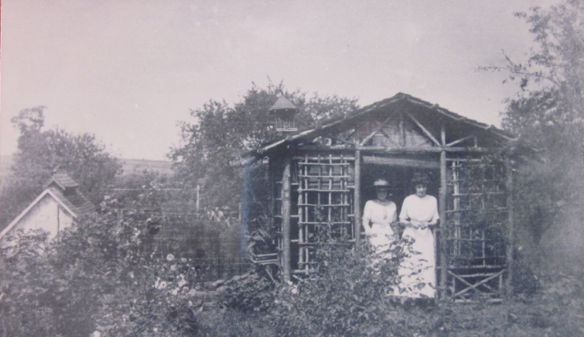
Meats would be preserved either “on the hoof” or by smoke curing. There was a small log smoke house for this purpose. I never saw this done, but from the looks of it, a smoldering, open fire would be maintained in a corner of the smoke house. The meats would be hung from the rafters on hooks. There was no chimney. The building just filled with the smoke of the fire and this process cooked and sealed the meat. I’m sure there is more art to this, and different woods would produce different flavors, but this is all I know. I have certainly eaten many smoked meats.
In the earlier days, cooking was on wood or coal, if available, and lighting was by fireside, candle or oil lamp. Heating was by fireplace or wood stove. Later on they made their own gas for lamps and cooking. They had an acetylene generator. It was a simple device that would store acetylene gas under pressure. The gas itself was the result of mixing carbide powder and water. A chamber created by a heavy inverted drum floating in another slightly larger drum of water captured and pressurized the gas.
The Gas House was, and is, a small underground “bunker” next to the ice house; as there was some risk of explosion with this gas. The acetylene was piped into the house to operate a warming stove in the main pantry and gas lighting throughout the house.
Around the turn of the 20th century, a coal fired, one pipe, steam heating system was installed in the main house. An existing shallow basement under the Dining Room was further excavated in order to fit the massive boiler and its piping. Prior to this, they basically kept 6 fireplaces burning in the winter, and wore a lot of layers of clothing.
After its retirement (1926), the unused ice house became a convenient place to throw trash, with which it is still quite full. No telling what might be found in there.
The farm is sold
I am not sure whether Green Mont would have been sold out of the family by the Fleming girls, but I bet they were very happy to have my father (William F. Rust Jr.) offer to buy them out. Perhaps it was an expected changing of the guard. Maybe it was initiated by my father for the benefit of his mother. I donʼt know. My father could be very nostalgic. It might have been for sale anyway.
Lee had left the farm to Roberta, Harriot and Anne. Clarissa already had a farm, which I think she called “West Hope”, that had been left to her by her buddy, Uncle Rob, back in 1929. Clarissa had already sold that by 1950 to a Gen. Campbell.
In 1959, Roberta, then 70 years old, was living in Leesburg, Va. in a little house across the street from her sister Mary. I think Harriot, then 60, still had a place in Washington, D.C. where she operated her dress shop, splitting her time between there and Homewood. Anne, 55, was living in Richmond. Mike Harris tells me that Anne was sort of the managing partner by that time. The farm was managed by who I now know to be Mr. Payne. Mr. Payne and his wife lived in Green Mont.
Here’s a little aside. I distinctly remember meeting the manager and his wife on my first visit to Green Mont in 1959 or 1960. I remember the kitchen, which still had its pantries and its wonderful smell and worn, well used feel. I was offered a freshly baked cookie by Mrs. Payne. I never knew their name, and none of my siblings have any memory of them.
In 2015, I was hosting an oral history get-together in The Plains and Jerri Rutledge shared with me me that she had lived at Green Mont for several years during the early to mid 1950’s with her parents after her first husband was killed in Korea. Her parents managed the farm for the Flemings. Her maiden name was Payne. A heavenly choir went off in my head. I was becoming convinced that I had dreamt this old white haired couple up.
These pictures were taken when we met at the farm with Anne Harris and Roberta Fleming in 1959. I wasn’t there. It was probably just my mother and father.


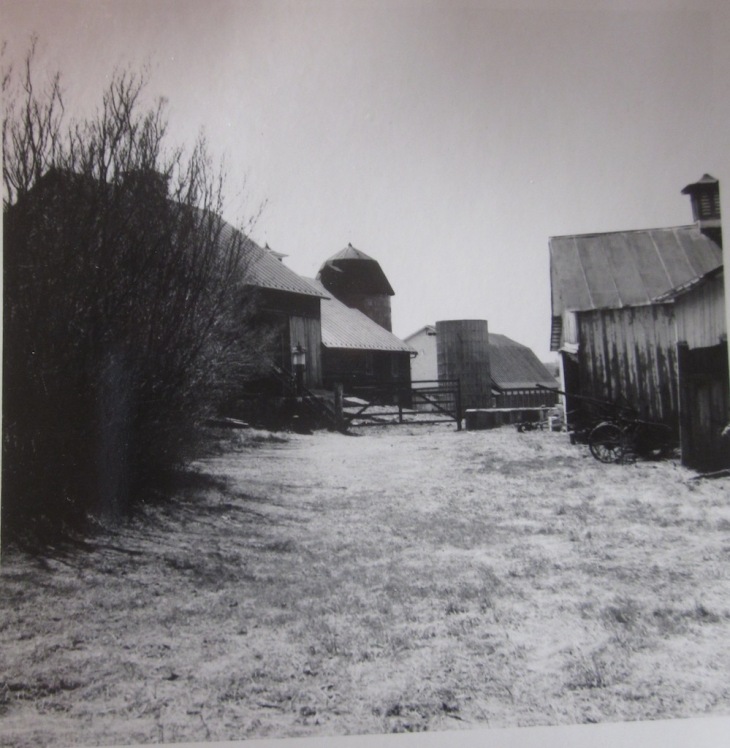
My father purchased Green Mont as an operating dairy farm in 1959, lock, stock and barrel, for @$90,000. Since the Green Mont house was still occupied, my parents rented another house for the summer of 1960. That house, at the base of the white rocks at Thoroughfare Gap, is called Roland. That was my first real experience of Virginia farm life. If I’m not mistaken, my brother, Bill, worked at Green Mont as a farm hand that summer of 1960 .
The close of a chapter


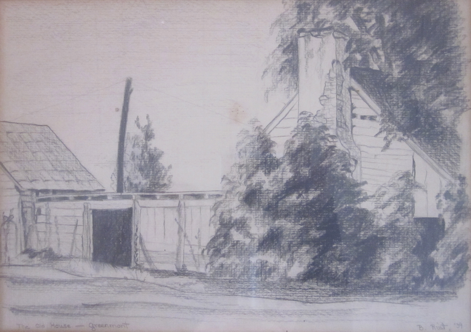
The Pignut Seminary story is quite a revelation. It helps to have architects and archaeologists in the family.
LikeLike
Marloe Woollett: I recall that every time I was in a car leaving
Green Mont, the long hill down to the main road was praised because the car
could coast, w/o using any gas, until reaching the very bottom before
starting the car….War Time Economies! Also, there was a big cellar,
complete with green folding tin doors on the outside of the house somewhere.
Only once, I got to go inside, and even now, I remember the damp earthy
smell, with hams and bunches of onions hanging down. Great stuff for a
little kid! No memories of “sliding down the cellar door,” however!
LikeLike